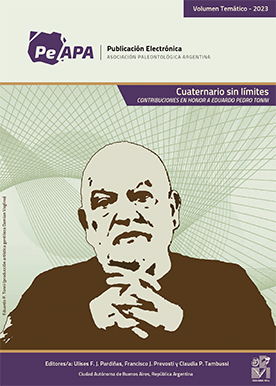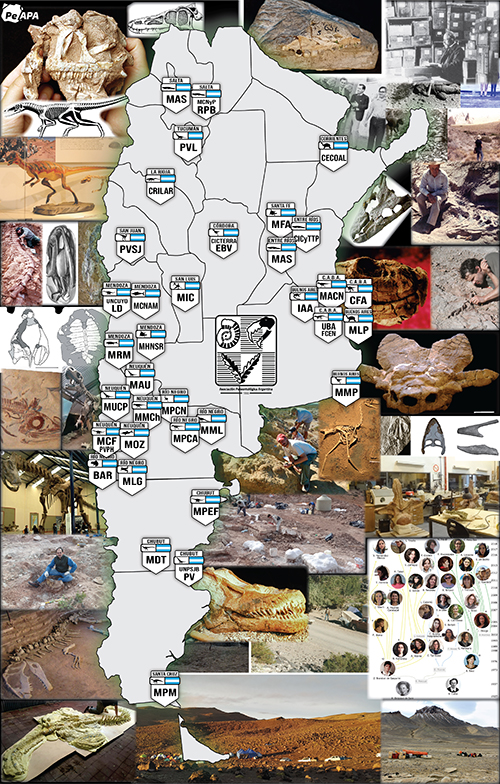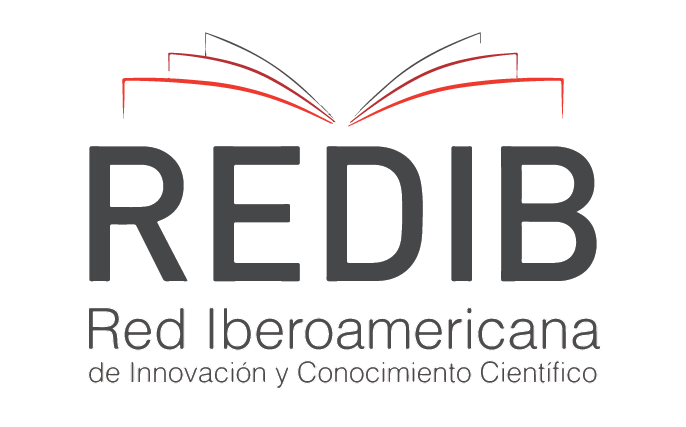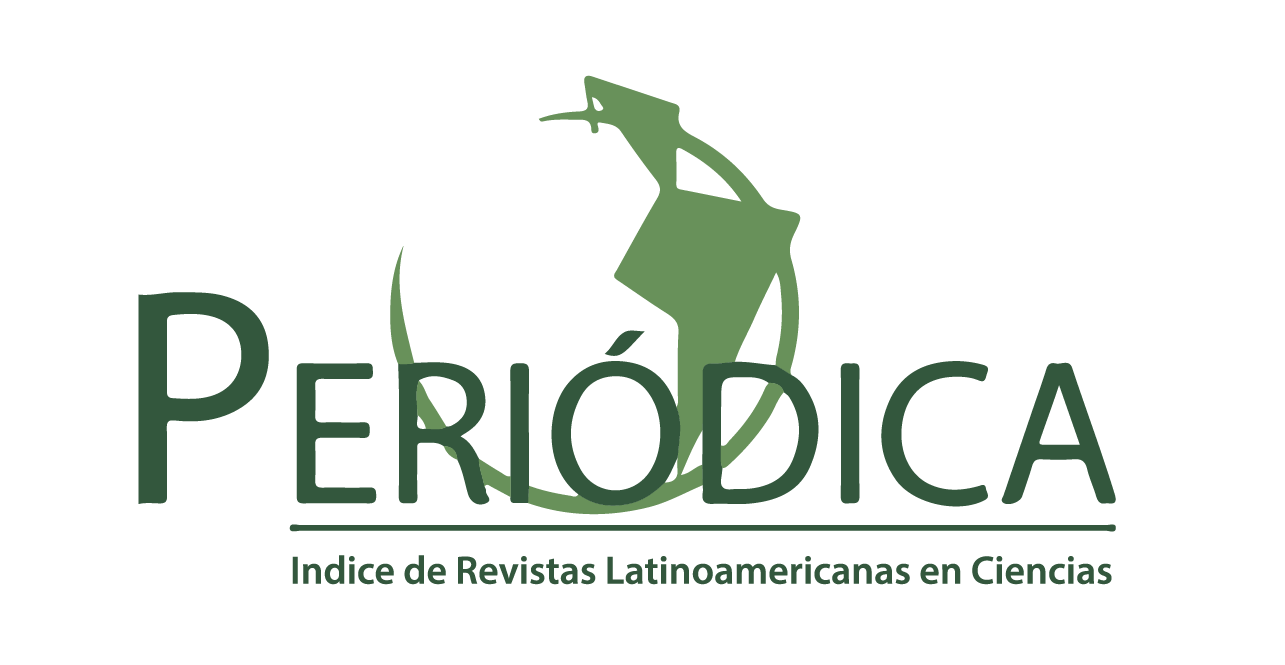CONTRIBUCIÓN AL CONOCIMIENTO DEL REGISTRO FÚNGICO FÓSIL EN BASE A ESTUDIOS PALINOMICOLÓGICOS DEL GRUPO EL FOYEL, CUENCA DE ÑIRIHUAU, PALEÓGENO, PATAGONIA ARGENTINA
DOI:
https://doi.org/10.5710/PEAPA.12.07.2024.508Palabras clave:
Esporas fúngicas fósiles, Inapertisporites, Grupo El Foyel, Formación Troncoso, OCEM, Paleógeno, ArgentinaResumen
Se describen e ilustran esporas, conidióforos e hifas de hongos fósiles recuperados de nueve muestras de fangolitas aflorantes en la sección Río Foyel, pertenecientes a las Formaciones Troncoso, Salto del Macho y Río Foyel (Grupo El Foyel). Se reconocieron representantes de 16 géneros. Entre las 26 especies descritas, se propone una nueva especie, Inapertisporites lacrimaformis. Las amerósporas son el tipo de esporas más abundantes. A partir del análisis palinoestratigráfico de los restos no polínicos (fúngicos), se sugiere una edad paleógena para el Grupo El Foyel. De las tres formaciones estudiadas, la Formación Troncoso es la que muestra la mayor abundancia y diversidad de restos fúngicos. Este rasgo podría estar evidenciando un período de condiciones climáticas óptimas (templado cálido y húmedo), probablemente relacionado con el Óptimo Climático del Eoceno Medio (OCEM). En base a las preferencias paleoecológicas de los especímenes recuperados del Grupo El Foyel, se podría inferir un ambiente boscoso próximo a un cuerpo de agua fluvial o lacustre.
Citas
Akulov, O. Y. & Hayova, V. P. (2016). Immotthia atrograna (Dacampiaceae, Ascomycota), a new for Ukraine fungicolous fungus from the Carpathians. Ukrainian Botanical Journal, 73(1), 84–89. https://doi.org/10.15407/ukrbotj73.01.084
Ambwani, K. (1983). Fungal remains from Neyveli Lignites, South India. Journal of Palaeosciences, 31, 148–153. https://doi.org/10.54991/jop.1983.1716
Asensio, M., Zavala, C. & Arcuri, M. (2005). Los sedimentos terciarios del río Foyel, provincia de Río Negro, Argentina. Abstracts of the 16º Congreso Geológico Argentino (pp. 271–276). La Plata.
Bajdek, P., Qvarnström, M., Owocki, K., Sulej, T., Sennikov, A. G., Golubev, V. K. & Niedźwiedzki, G. (2016). Microbiota and food residues including possible evidence of pre-mammalian hair in Upper Permian coprolites from Russia. Lethaia, 49(4), 455–477. https://doi.org/10.1111/let.12156
Bechis, F., Encinas, A., Concheyro, A., Litvak, V. D., Aguirre-Urreta, B. & Ramos, V. A (2014). New age constraints for the Cenozoic marine transgressions of northwestern Patagonia, Argentina (41°–43° S): Paleogeographic and tectonic implications. Journal of South American Earth Sciences, 52, 72–93. https://doi.org/10.1016/j.jsames.2014.02.003
Bernardo, L. M., Zamora Valcarce, G., Folguera, A. & Zapata, T. (2009). Nuevo Modelo Exploratorio y Definición de los Sistemas Petroleros de la Cuenca de Ñirihuau, Cordillera Patagónica, Argentina. Abstracts of the10° Simposio Bolivariano Exploración Petrolera en Cuencas Subandinas. Cartagena, Colombia.
Bianchinotti M. V., Cornou M. E. & Martínez M. A. (2017). Hongos epífilos fósiles del Paleógeno de la Cuenca de Ñirihuau, Argentina. Boletín de la Sociedad Argentina de Botánica, Volumen 52 (Suplemento) (p.289). Córdoba.
Bianchinotti, M. V., Martínez, M. A. & Cornou, M. E. (2020). The utility of Desmidiospora: a paradigm shift based on Paleogene fungal remains from the Ñirihuau Basin, Argentina. Palynology, 44(4), 587–596. https://doi.org/10.1080/01916122.2019.1657514
Bippus, A. C., Escapa, I. H., Wilf, P. & Tomescu, A. M. (2019). Fossil fern rhizomes as a model system for exploring epiphyte community structure across geologic time: evidence from Patagonia. PeerJ, 7, e8244. https://doi.org/10.7717/peerj.8244
Braun, U., Nakashima, C. & Crous, P. W. (2013). Cercosporoid fungi (Mycosphaerellaceae) 1. Species on other fungi, Pteridophyta and Gymnospermae. IMA fungus, 4, 265–345. https://doi.org /10.5598/imafungus.2013.04.02.12
Brea, M. & Zucol, A. F. (2007). Guadua zuloagae sp. nov., the first petrified bamboo culm record from the Ituzaingó Formation (Pliocene), Paraná Basin, Argentina. Annals of Botany, 100(4), 711–723. https://doi.org/10.1093/aob/mcm175
Brea, M., Zucol, A. F. & Franco, M. J. (2013). A new Bambusoideae (Poaceae: Bambusoideae: Bambuseae: Guaduinae) from the Ituzaingó Formation (Pliocene–Pleistocene), Entre Ríos, Argentina. Review of Palaeobotany and Palynology, 192, 1–9. https://doi.org/10.1016/j.revpalbo.2012.12.006
Calhim, S., Halme, P., Petersen, J. H., Læssøe, T., Bässler, C. & Heilmann–Clausen, J. (2018). Fungal spore diversity reflects substrate-specific deposition challenges. Scientific Reports, 8(1), 5356. https://doi.org/10.1038/s41598-018-23292-8
Catania, M., Romero, A. I., Huhndorf, S. M. & Miller, A. N. (2011). A new species and new records of Cercophora from Argentina. Mycologia, 103(6), 1372–1383.
Cheewangkoon, R., Groenewald, J. Z., Hyde, K. D., To-anun, C. & Crous, P. W. (2012). Chocolate spot disease of Eucalyptus. Mycological Progress, 11, 61–69. https://doi.org/10.1007/s11557-010-0728-8
Cornou, M. E. (2012). Palinoloestratigrafía y Palinofacies del Eoceno medio–Oligoceno en la parte central de la Cuenca de Ñirihuau, Argentina. [Tesis Doctoral Inédita]. Universidad Nacional del Sur, Argentina. http://repositoriodigital.uns.edu.ar/handle/123456789/2268
Cornou, M. E., Quattrocchio, M. E., & Martínez, M. A. (2014). Palinoestratigrafía de la Formación Salto del Macho, Paleógeno de la Cuenca de Ñirihuau, Argentina. Ameghiniana, 51(6), 556–571. https://doi.org/10.5710/AMGH.14.10.2014.2801
Cornou, M. E., Quattrocchio, M. E. & Martínez, M. A. (2018). Paleoclimas y paleoambientes del Grupo El Foyel (Paleógeno-Neógeno Temprano) de la Cuenca de Ñirihuau, Argentina. Boletín de la Asociación Latinoamericana de Paleobotánica y Palinología 18, pp. 67–68.
Crandall, S. G., Saarman, N. & Gilbert, G. S. (2020). Fungal spore diversity, community structure, and traits across a vegetation mosaic. Fungal Ecology, 45, 100920. https://doi.org/10.1016/j.funeco.2020.100920
Cugny, C., Mazier, F. & Galop, D. (2010). Modern and fossil non–pollen palynomorphs from the Basque mountains (western Pyrenees, France): the use of coprophilous fungi to reconstruct pastoral activity. Vegetation history and Archaeobotany, 19, 391–408.
Dangeard, P. A. (1896). Une maladie du peuplier dans l’ouest de la France. Le Botaniste, 5,38–43.
Davey, M. L., Tsuneda, A. & Currah, R. S. (2008). Evidence that the gemmae of Papulaspora sepedonioides are neotenous perithecia in the Melanosporales. Mycologia, 100(4), 626–635. https://doi.org/10.3852/08-001R
Daws, S. C., Cline, L. A., Rotenberry, J., Sadowsky, M. J., Staley, C., Dalzell, B. & Kennedy, P. G. (2020). Do shared traits create the same fates? Examining the link between morphological type and the biogeography of fungal and bacterial communities. Fungal Ecology, 46, 100948. https://doi.org/10.1016/j.funeco.2020.100948
Diez, O. & Zubia, M. (1981). Sinopsis estratigráfica de la región de El Bolsón, provincia de Río Negro. Revista de la Asociación Geológica Argentina, 36(1), 19–28.
Douhan, G. W. & Rizzo, D. M. (2003). Host–parasite relationships among bolete infecting Hypomyces species. Mycological research, 107(11), 1342–1349. https://doi.org/10.1017/S0953756203008542
Dueñas–Jiménez, H. (1979). Estudio palinológico de los 35 mts. superiores de la Sección Tarragona, Sabana de Bogotá. Caldasia, 539–571. https://www.jstor.org/stable/43405933
El Atfy, H., Brocke, R. & Uhl, D. (2013). A fungal proliferation near the probable Oligocene/Miocene boundary, Nukhul Formation, Gulf of Suez, Egypt. Journal of Micropalaeontolgy, 32(2), 183–195. https://doi.org/10.1144/jmpaleo2013-004
Elsik, W. C. (1968). Palynology of a Paleocene Rockdale lignite, Milam County, Texas. I. Morphology and taxonomy. Pollen et Spores, 10, 263–314.
Elsik, W. C. (1990). Hypoxylonites and Spirotremesporites, form genera for Eocene to Pleistocene fungal spores bearing a single furrow. Palaeontographica: Abteilung B. Paläophytolo, 216(5-6), 137–169.
Elsik, W. C. & Jansonius, J. (1974). New genera of Paleogene fungal spores. Canadian Journal of Botany, 52(5), 953–958.
Elsik, W. C. & Yancey, T. E. (2000). Palynomorph biozones in the context of changing paleoclimate, middle Eocene to lower Oligocene of the Northwest Gulf of Mexico. Palynology, 24(1), 177-186. https://doi.org/10.1080/01916122.2000.9989543
Elsik, W. C., Ediger, V. S. & Bati, Z. (1990). Fossil fungal spores: Anatolinites nov. gen. Palynology, 14, 91–103. http://www.jstor.org/stable/3687500
Ethridge Glass, D. L., Brown, D. D. & Elsik, W. C. (1986). Fungal spores from the upper Eocene Manning Formation, Jackson Group, East and South–Central Texas, US A. Pollen et spores, 28(3-4), 403–420.
Ferreira, E. P., de Araujo Carvalho, M. & Viviers, M. C. (2005). Palinologia (fungos) da Formação Calumbi, Paleoceno da Bacia de Sergipe, Brasil. Arquivos do Museu Nacional, Rio de Janeiro, 63(3), 395–410.
Frenguelli, J. & Parodi, L. (1941). Una Chusquea fósil de El Mirador. Notas del Museo de La Plata. Paleontología 4, 35–38.
Fritel, P. H. & Viguier, R. (1909). Les Equisetum fossiles et leur structure. Revue Générale de Botanique, 21, 129–142.
García Massini, J., Channing, A., Guido, D. M. & Zamuner, A. B. (2012). First report of fungi and fungus-like organisms from Mesozoic hot springs. Palaios, 27(1), 55–62. https://doi.org/10.2110/palo.2011.p11-076r
Gelorini, V., Verbeken, A., Lens, L., Eggermont, H., Odgaard, B. V. & Verschuren, D. (2012). Effects of land use on the fungal spore richness in small crater-lake basins of western Uganda. Fungal Diversity, 55, 125–142. https://doi.org/10.1007/s13225-012-0155-z
Gelorini, V., Verbeken, A., van Geel, B., Cocquyt, C. & Verschuren, D. (2011). Modern non-pollen palynomorphs from East African lake sediments. Review of Palaeobotany and Palynology, 164(3-4), 143–173. https://doi.org/10.1016/j.revpalbo.2010.12.002
González Bonorino, F. (1973). Geología del área entre San Carlos de Bariloche y Llao-Llao. Fundación Bariloche, Departamento de Recursos Naturales y Energía. 16, 1–53.
González Bonorino, F. & González Bonorino, G. (1978). Geología de la región de San Carlos de Bariloche: un estudio de las formaciones terciarias del Grupo Nahuel Huapi. Revista de la Asociación Geológica Argentina, 33 (3), 175–210
Guimarães, J. T. F., Nogueira, A. C. R., Da Silva, J. B. C., Soares, J. L. & Silveira, R. (2013). Fossil fungi from Miocene sedimentary rocks of the central and coastal Amazon region, North Brazil. Journal of Paleontology, 87(3), 484–492. https://doi.org/10.1666/12-091.1
Hooghiemstra, H. (2012). Non-pollen palynomorphs: From unknown curiosities to informative fossils. Celebrating the scientific career of Bas van Geel. Review of Palaeobotany and Palynology, 186, 2–4. https://doi.org/10.1016/j.revpalbo.2012.07.015
Hughes, S. J. (2007). Heteroconium and Pirozynskiella n. gen., with comments on conidium transseptation. Mycologia, 99(4), 628–638. https://doi.org/10.1080/15572536.2007.11832557
Kalgutkar, R. M. (1993). Paleogene fungal palynomorphs from Bonnet Plume formation, Yukon Territory. Bulletin of the Geological Survey of Canada, 444, 51–105.
Kalgutkar, R. M. (1997). Fossil fungi from the lower Tertiary Iceberg Bay Formation, Eukeka Sound Group, Axel Heiberg Island, Northwest Territories, Canada. Review of Palaeobotany and Palynology, 97(1-2), 197–226. https://doi.org/10.1016/S0034-6667(96)00071-1
Kalgutkar, R. M. & Jansonius, J. (2000). Synopsis of fossil fungal spores, mycelia and fructifications. Contributions Series-American Association of Stratigraphic Palynologists, 39.
Kalgutkar, R. M. & Sigler, L. (1995). Some fossil fungal form-taxa from the Maastrichtian and Palaeogene ages. Mycological Research, 99(5), 513–522. https://doi.org/10.1016/S0953-7562(09)80706-5
Kar, R. K. (1979). Palynological fossils from the Oligocene sediments and their biostratigraphy in the district of Kutch, western India. Palaeobotanist, 26(1), 16–49.
Kar, R. K. (1990). Palynology of Miocene and Mio-Pliocene sediments of north-east India. Journal of Palynology, 26, 171–217.
Ke, P. & Shi, Z. Y. (1978). Early Tertiary spores and pollen grains from the coastal region of the Bohai. Academy of Petroleum Exploration, Development and Planning Research of the Ministry of Petroleum and Chemical Industries and the Nanjing Institute of Geology, and Paleontology, Chinese Academy of Sciences, Kexue Chubanshe, Peking, China, 177 pp.
Koske, R. E. (1985). Glomus aggregatum emend: A distinct taxon in the Glomus fasciculatum complex. Mycologia, 77(4), 619–630.
Kumar, P. (1990). Fungal remains from the Miocene Quilon beds of Kerala State, south India. Review of Palaeobotany and Palynology, 63(1-2), 13–28. https://doi.org/10.1016/0034-6667(90)90003-2
Lange, R. T. & Smith, P. H. (1971). The Maslin Bay flora, South Australia. 3. Dispersed fungal spores. Neues Jahrbuch fur Geologie und Paliiontologie Monatshefte, 11, 663–681.
Martínez, M. A., Bianchinotti, M. V., Saxena, R. K., Cornou, M. E. & Quattrocchio, M. E. (2016). Fungal spores from the Palaeogene El Foyel Group of Ñirihuau Basin, Argentina. Papers in Palaeontology, 2(3), 343–362. https://doi.org/10.1002/spp2.1044
Nandi, B., Banerjee, S. & Sinha, A. (2003). Fossil Xylariaceae spores from the Cretaceous and Tertiary sediments of Northeastern India. Acta Palaeontologica Sinica, 42, 56–67.
Norris, G. (1986). Systematic and stratigraphic palynology of Eocene to Pliocene strata in the Imperial Nuktak C-22 well, Mackenzie Delta region, District of Mackenzie, NWT. Geological Survery of Canada, Bulletin, 340, 1–89.
Norris, G. (1997). Paleocene-Pliocene deltaic to inner shelf palynostratigraphic zonation, depositional environments and paleoclimates in the Imperial Adgo F-28 well, Beaufort-Mackenzie Basin. Geological Survey of Canada, 523, p. 71. https://doi.org/10.4095/209361
Nuñez Otaño, N. B. N., Bianchinotti, M. V. & Saparrat, M. C. (2021). Palaeomycology: a modern mycological view of fungal palynomorphs. Geological Society, London, Special Publications, 511 (1), 91–120. https://doi.org/10.1144/SP511-2020-47
O'Keefe, J. M. (2017). Fungal palynomorphs from the Miocene Heath Formation, Tumbes Province, Perú. Palynology, 41, 309–326. https://doi.org/10.1080/01916122.2017.1366193
O'Keefe, J. M., Otaño, N. B. N. & Bianchinotti, M. V. (2021). Nomenclature: How do we designate NPP taxa?. In Marret, F., O’Keefe, J., Osterloff, P., Pound, M. and Shumilovskikh, L. (Eds), Applications of Non-Pollen Palynomorphs: from Palaeoenvironmental Reconstructions to Biostratigraphy. Geological Society, London, Special Publications, 511. https://doi.org/10.1144/SP511-2020-119
Palynodata Inc. & White, J. M. (2006). Palynodata datafile: 2006 version with introduction by J. M. White. Geological Survey of Canada. https://doi.org/10.4095/225704
Parsons, M. G. & Norris, G. (1999). Paleogene fungi from the Caribou Hills, Mackenzie Delta, northern Canada; Paleogene fungi from the Caribou Hills, Mackenzie Delta, northern Canada. Palaeontographica Abteilung B, 250(4-6), 77–167. https://doi.org/10.1127/palb/250/1999/77
Pathak, N. R. & Banerjee, M. (1984). Fungal spores from the Neogene sediments of the Eastern Himalayan foothills, Darjeeling district. Abstracts of the 10 Indian colloquium on micropaleontology and stratigraphy, (pp 245–260). Pune.
Pilie, M., Gibson, M. E., Romero, I. C., Nuñez Otaño, N. B., Pound, M. J., O'Keefe, J. M., & Warny, S. (2023). Miocene Climatic Optimum fungal record and plant-based CREST climatic reconstruction from southern McMurdo Sound, Antarctica. Journal of Micropalaeontology, 42(2), 291–307. https://doi.org/10.5194/jm-42-291-2023
Pirozynski, K. A. & Weresub, L. K. (1979). The classification and nomenclature of fossil fungi. In Kendrick, B. (Ed.), The whole fungus, the sexual-asexual synthesis. Abstracts of the 2º International Mycological Conference, 2, (pp. 653–688). Calgary.
Pöthe de Baldis, E. D. (1984). Microfloras cenozoicas. In: Ramos VA (ed) Geología y recursos naturales de la Provincia de Río Negro. Abstracts of the 9º Congreso Geológico Argentino, 2, (pp. 393–411). San Carlos de Bariloche.
Premaor, E., Saxena, R. K., de Souza, P. A. & Kalkreuth, W. (2018). Fungal spores and fruiting bodies from Miocene deposits of the Pelotas Basin, Brazil. Revue de micropaléontologie, 61(3-4), 255–270. https://doi.org/10.1016/j.revmic.2018.08.002
Quattrocchio, M., Durango de Cabrera, J. & Galli, C. (2003). Formación Anta (Mioceno Temprano/Medio), Subgrupo Metán (Grupo Orán), en el río Piedras, Pcia. de Salta: Datos palinológicos. Revista de la Asociación Geológica Argentina, 58(1), 117–127.
Quattrocchio, M. E., Martínez, M. A., Asensio, M. A., Cornou, M., & Olivera, D. E. (2012). Palynology of El Foyel Group (Paleogene), Ñirihuau Basin, Argentina. Revista Brasileira de Paleontologia, 15(1), 67–84. https://doi.org/10.4072/rbp.2012.1.06
Ramírez, R. (2004). Middle to late Eocene dinoflagellate cysts and fungal spores from the east coast of the Maracaibo lake, Venezuela: (Biostratigraphy, Palaeoecology and Taxonomy). [Dissertation an der Geowissenschaftlichen Fakultät der Eberhard-Karls-Universität Tübingen].
Ravazzoli, I. A. & Sesana, F. L. (1977). Descripción geológica de la Hoja 41c, Río Chico. Servicio Geológico Nacional.
Réblová, M., Hernández–Restrepo, M., Fournier, J. & Nekvindová, J. (2020). New insights into the systematics of Bactrodesmium and its allies and introducing new genera, species and morphological patterns in the Pleurotheciales and Savoryellales (Sordariomycetes). Studies in Mycology, 95(1), 415–466. https://doi.org/10.1016/j.simyco.2020.02.002
Revelles, J., Burjachs, F., & van Geel, B. (2016). Pollen and non-pollen palynomorphs from the Early Neolithic settlement of La Draga (Girona, Spain). Review of Palaeobotany and Palynology, 225, 1–20. https://doi.org/10.1016/j.revpalbo.2015.11.001
Romero, E. J. & Castro, M. T. (1986). Material fúngico y granos de polen de angiospermas de la Formación Río Turbio (Eoceno), provincia de Santa Cruz, República Argentina. Ameghiniana, 23(1-2), 101–118.
Romero, I. C., Nuñez Otaño, N. B., Gibson, M. E., Spears, T. M., Fairchild, J., Tarlton, L., Jones, S., Belkin, H. E., Warny, S., Pound, M. J. & O’Keefe, J. M. K. (2021). First Record of Fungal Diversity in the Tropical and Warm-Temperate Middle Miocene Climate Optimum Forests of Eurasia. Frontiers in Forests and Global Change, 4, 768405. https://doi.org/10.3389/ffgc.2021.768405
Sah, S. C. D. & Kar, R. K. (1974). Palynology of the Tertiary sediments of Palana, Rajasthan. Palaeobotanist, 21(2), 163–188.
Sahr, T., Ammer, H., Besl, H. & Fischer, M. (1999). Infrageneric classification of the boleticolous genus Sepedonium: species delimitation and phylogenetic relationships. Mycologia, 91(6), 935–943. https://doi.org/10.1080/00275514.1999.12061104
Salard-Cheboldaeff, M. & Locquin, M. V. (1980). Champignons presents au Tertiare le long du littoral de l’Afrique equatoriale. 183–195. In BOUREAU, E. (ed.). Paleobotanique. Comptes Rendus du 105e Congres national des Societes savantes, Caen, 1980, Sciences, 1, 183–195.
Samarakoon, M. C., Hyde, K. D., Maharachchikumbura, S. S. N., Stadler, M., Gareth Jones, E. B., Promputtha, I., Suwannarach, N., Camporesi, E., Bulgakov, T. S. & Liu, J. K. (2022). Taxonomy, phylogeny, molecular dating and ancestral state reconstruction of Xylariomycetidae (Sordariomycetes). Fungal Diversity, 112, 1–88. https://doi.org/10.1007/s13225-021-00495-5
Sánchez, R. M. & Bianchinotti, M. V. (2023). New records of mitosporic ascomycetes on Nothofagaceae from Patagonia, Argentina. Boletín de la Sociedad Argentina de Botánica, 58(4), 491-503. https://doi.org/10.31055/1851.2372.v58.n4.42019
Sarkar, S., Bhattacharya, A. P. & Singh, H. P. (1994). Palynology of Middle Siwalik sediments (Late Miocene) from Bagh Rao, Uttar Pradesh. Journal of Palaeosciences, 42(2), 199-209. https://doi.org/10.54991/jop.1993.1147
Sattraburut, T., Ratanasthien, B. & Thasod, Y. (2023). Fungal Spores from Neogene Sediments of the Hongsa Basin, Lao PDR. Tropical Natural History, 23, 82–96.
Saxena, R. K. & Khare, S. (1992). Fungal remains from the Neyveli Formation of Tiruchirapalli District, Tamil Nadu, India. Geophytology, 21, 37–43.
Saxena, R. K. & Tripathi, S. K. M. (2011). Indian fossil fungi. Journal of Palaeosciences, 60(1-2), 1–208. https://doi.org/10.54991/jop.2011.167
Saxena, R. K., Wijayawardene, N. N., Dai, D. Q., Hyde, K. D. & Kirk, P. M. (2021). Diversity in fossil fungal spores. Mycosphere, 12(1), 670–874. https://doi.org/10.5943/mycosphere/12/1/8
Schmiedeknecht, M. & Schwab, G. (1964). Bulbillen fossiler Pilze aus einer tertiären Weichbraunkohle. Deutsche Akademie der Wissenschaften zu Berlin, 6(9), 683–692.
Schüßler, A., Krüger, M. & Walker, C. (2011). Revealing natural relationships among arbuscular mycorrhizal fungi: culture line BEG47 represents Diversispora epigaea, not Glomus versiforme. PloS one, 6(8), e23333. https://doi.org/10.1371/journal.pone.0023333
Senwanna, C., Hyde, K. D., Phookamsak, R., Jones, E. G. & Cheewangkoon, R. (2018). Coryneumheveanum sp. nov. (Coryneaceae, Diaporthales) on twigs of Para rubber in Thailand. MycoKeys, (43), 75–90. https://doi.org/10.3897/mycokeys.43.29365
Sepúlveda, E. G. (1980). Estudio palinologico de sedimentitas intercaladas en la “Serie Andesitica Andina”, cordon occidental del Futalaufquen, Chubut. Parte I: Restos de Hongos. Revista de la Asociacion Geologica Argentina, 35, 248–272.
Sheffy, M. V. & Dilcher, D. L. (1971). Morphology and taxonomy of fungal spores. Palaeontographica, Abt. B, 133, 34–51.
Shumilovskikh, L. S, O’Keefe, J. M. K. & Marret, F. (2021). An overview of the taxonomic groups of NPPs. In: Marret F, O’Keefe J, Osterlof P, Pound M, Shumilovskikh L (eds). Applications of Non-pollen Palynomorphs: from palaeoenvironmental reconstructions to biostratigraphy., 511, (pp. 13–61). Geological Society, Special Publications. https://doi.org/10.1144/SP511-2020-65
Singh, H. P. & Saxena, R. K. (1980). Upper Siwalik palynoflora from Gagret Bharwain Road Section, Himachal Pradesh. Geophytology,10(2): 278–279.
Singh, S. K. & Chauhan, M. S. (2008). Fungal remains from the Neogene sediments of Mahuadanr Valley, Latehar District, Jharkhand, India and their palaeoclimatic significance. Journal of the Palaeontological Society of India, 53(1), 73–81.
Song, Z. C. & Cao, L. (1994). Late Cretaceous fungal spores from King George Island, Antarctica. Stratigraphy and palaeontology of Fildes Peninsula, King George Island, Antarctica. Beijing: Science Press. State Antarctic Committee, Monograph, 3, 37–49.
Song, Z. C., Zheng, Y., Li, M., Zhang, Y., Wang, W., Wang, D., Zhou, S. & Zhao, Y. (1999). Fossil spores and pollen of China. The Late Cretaceous and Tertiary spores and pollen. Science Press, Beijing, 17(910), 207.
Song, Z., Li, G., Cao, L., Luo, H. & Sun, Z. H. (1989). Early Tertiary sporo-pollen assemblages from the Dongpu region. Research Institute of Exploration and Development, Zhongyuan Petroleum Exploration Bureau, Nanjing Institute of Geology and Palaeontology, Academia Sinica.
Souza Silva, R. S. (2015). Considerações paleoambientais, com base em fungos quaternários, de turfas de Eugênio de Melo, médio vale do Rio Paraíba do Sul, SP, Brasil. [[PhD thesis, Universidade Guarulhos]. Centro de Pósgraduacao e Pesquisa.
Sutton, B. C. & Sellar, P. W. (1966). Toxosporiopsis n. gen., an unusual member of the Melanconiales. Canadian Journal of Botany, 44(11), 1505–1513. https://doi.org/10.1139/b66-165
Sutton, B. C. (1986). Improvizations on conidial themes. Transactions of the British mycological Society, 86(1), 1–38. https://doi.org/10.1016/S0007-1536(86)80115-2
Taylor, T. H., Krings, M. & Taylor, E. D. (2015). Fossil fungi. Academic Press, Elsevier, Amsterdam. https://doi.org/10.1111/njb.00811
Vajda, V. (2012). Fungi, a driving force in normalization of the Terrestrial Carbon Cycle Following the End-Cretaceous Extinction. In: Talent, J. A. (Ed), Earth and Life: Global biodiversity, extinction intervals and biogeographic perturbations through time, 811–817. Springer, Dordrecht. https://doi.org/10.1007/978-90-481-3428-1_27
van Asperen, E. N., Kirby, J. R. & Shaw, H. E. (2020). Relating dung fungal spore influx rates to animal density in a temperate environment: implications for palaeoecological studies. The Holocene, 30(2), 218–232. https://doi.org/10.1177/0959683619875804
van der Hammen, T. (1954). El desarrollo de la flora colombiana en los periodos geológicos. Boletín Geológico, 2(1), 49–106. https://doi.org/10.32685/0120-1425/bolgeol2.1.1954.387
van Geel, B. (1978). A palaeoecological study of holocene peat bog sections in Germany and The Netherlands, based on the analysis of pollen, spores and macro- and microscopic remains of fungi, algae, cormophytes and animals. Review of Palaeobotany and Palynology, 25(1), 1–120. https://doi.org/10.1016/0034-6667(78)90040-4.
van Geel, B., Bohncke, S. J. P. & Dee, H. (1981). A palaeoecological study of an upper Late Glacial and Holocene sequence from “De Borchert”, The Netherlands. Review of palaeobotany and palynology, 31, 367-448. https://doi.org/10.1016/0034-6667(80)90035-4
van Geel, B., Gelorini, V., Lyaruu, A., Aptroot, A., Rucina, S., Marchant, R., Sinninghe Damsté J. S. & Verschuren, D. (2011). Diversity and ecology of tropical African fungal spores from a 25,000–year palaeoenvironmental record in southeastern Kenya. Review of Palaeobotany and Palynology, 164(3-4), 174–190. https://doi.org/10.1016/j.revpalbo.2011.01.002
Varma C. P. & Rawat M. S. (1963). A Note on Some Diporate Grains Recovered from Tertiary Horizons of India and Their Potential Marker Value. Grana, (4), 130–139. 13010.1080/00173136309437866
Vermeij, G. J. & Grosberg, R. K. (2010). The great divergence: when did diversity on land exceed that in the sea?. Integrative and Comparative Biology, 50(4), 675–682. https://doi.org/10.1093/icb/icq078
Větrovský, T., Kohout, P., Kopecký, M.,Machac, A., Man, M., Bahnmann, B. D., Brabcová, V., Choi, J., Meszárošová, L., Human, Z. R., Lepinay, C., Lladó, S., López-Mondéjar, R., Martinović, T., Mašínová, T., Morais, D., Navrátilová, D., Odriozola, I., Štursová, M.,… Baldrian, P. (2019). A meta-analysis of global fungal distribution reveals climate-driven patterns. Nature communications, 10(1), 5142. https://doi.org/10.1038/s41467-019-13164-8
Volkheimer, W. & Melendi, D. L. (1976). Palinomorfos como fosiles guıa (3° parte). Tecnicas de laboratorio palinologico. Revista Minera de Geología y Mineralogía, 34, 19–30.
von Schweinitz L. D. (1834) Synopsis fungorum in America boreali media degentium. Transactions of the American Philosophical Society,4(2), 141–316.
Walker, C., Gollotte, A. & Redecker, D. A. (2018). A new genus, Planticonsortium (Mucoromycotina), and new combination (P. tenue), for the fine root endophyte, Glomus tenue (basionym Rhizophagus tenuis). Mycorrhiza, 28(3), 213–219. https://doi.org/10.1007/s00572-017-0815-7.
White, J. M. & Ager, T. A. (1994). Palynology, paleoclimatology and correlation of Middle Miocene beds from Porcupine River (locality 90-1), Alaska. Quaternary International, 22, 43–77. https://doi.org/10.1016/1040-6182(94)90006-X
Wilf, P. (2020). Eocene “Chusquea” fossil from Patagonia is a conifer, not a bamboo. PhytoKeys, 139, 77–89. https://doi.org/10.3897/phytokeys.139.48717
Worobiec, G. & Worobiec, E. (2013). Epiphyllous fungi from the Oligocene shallow-marine deposits of the Krabbedalen Formation, Kap Brewster, central East Greenland. Acta Palaeobotanica, 53(2), 165–179. https://doi.org/10.2478/acpa-2013-0014
Yang, J., Maharachchikumbura, S. S., Bhat, D. J., Hyde, K. D., McKenzie, E. H. C., Jones, E. B. G., Al-Sadi, A. M. & Lumyong, S. (2016). Fuscosporellales, a new order of aquatic and terrestrial Hypocreomycetidae (Sordariomycetes). Cryptogamie, Mycologie, 37(4), 449–475.
Yang, H., Dong, W., Yu, X. D., Bhat, D. J., Boonmee, S. & Zhang, H. (2020). Four freshwater dematiaceous hyphomycetes in Sordariomycetes with two new species of Parafuscosporella. Phytotaxa, 441(1), 19–34.
Yonezawa, H., Sato, G., Hiro, Y., Tanaka, K. & Hosoya, T. (2008). Six Dematiaceous Conidial Fungi New to Japan from Yakushima Island. Bulletin of the National Museum of Nature and Science, Series B 34(3), 119–126.
Zhang, Y., Crous, P. W., Schoch, C. L., Bahkali, A. H., Guo, L. D. & Hyde, K. D. (2011). A molecular, morphological and ecological re-appraisal of Venturiales―a new order of Dothideomycetes. Fungal Diversity, 51, 249–277 (2011). https://doi.org/10.1007/s13225-011-0141-x
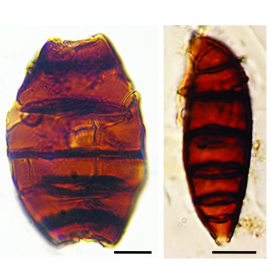
Archivos adicionales
Publicado
Número
Sección
Licencia
Derechos de autor 2024 Marcelo Adrián Martínez, María Virginia Bianchinotti, María Elina Cornou

Esta obra está bajo una licencia internacional Creative Commons Atribución-SinDerivadas 4.0.

Los/las autores/as conservan los derechos de autor/a y garantizan a la revista el derecho de ser la primera publicación del trabajo licenciado bajo una licencia CC Attribution-NonCommercial 4.0 que permite a otros/as compartir el trabajo con el reconocimiento de la autoría y de la publicación inicial en esta revista.







